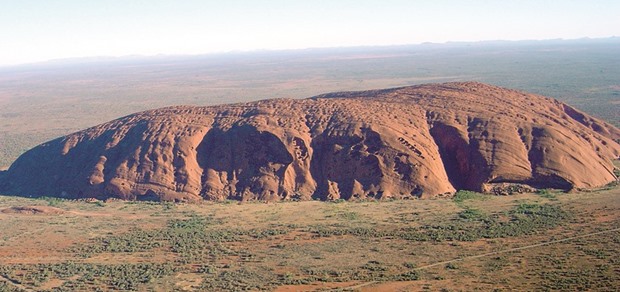I saw a great video of a waterfall the other day. At first I assumed it was somewhere tropical, but I took a double-take as the people in the film appeared a bit too surprised and delighted; clearly all wasn’t as it seemed. On closer inspection it turned out that the waterfall was actually falling down the side of Uluru, in the middle of the Australian desert.
Uluru, which used to be known as Ayers Rock, is a huge red monolith which rises abruptly out of plains of central Australia. It’s 348 metres (1,140 feet) high, which makes it taller than the Eiffel Tower in Paris, and has a circumference of over 9 kilometres. It’s Australia’s most famous rock and is sacred to the indigenous population. It’s believed to be about 600 million years old and its bright red colour comes from the oxidisation, or the rusting, of the iron in the rock.
At this time of year, Uluru is usually a very hot and dry place. Although Doha is enjoying its winter, Australia is in the southern hemisphere and is currently in the middle of summer. The temperature has been known to reach as high as a stifling 47C (117F), but towards the end of last month, the temperatures weren’t anywhere near that high. The maximum temperature on December 24 was 7C (12F) below average and two days later, with a maximum temperature of just 27C (81F), the temperature was 9C (16F) lower than usual.
As well as being cooler than usual, the weather was also very, very wet, thanks at least in part due to a tropical cyclone which formed to the northwest of Australia. The storm, called Yvette, was the first to form in the waters around Australia this season. It weakened before it made landfall, so the winds weren’t strong enough for the system to be classified as a tropical cyclone, but it joined forces with another area of low pressure in the area, and produced a phenomenal amount of rain as it barrelled across the country.
The system came ashore in Broome, a town with a population of approximately 15,000 people on the northwest coast. The town was drenched with 226mm (8.9 inches) of rain in just 24 hours. This was a phenomenal amount of rain, the third wettest day that Broome had ever seen and the wettest December day ever reported. Incredibly the torrential rain only caused minor flooding and a few road closures in the area. The deluge came at the end of a very wet month for the area, bringing Broome’s December total to more than 407mm (16.0 inches), the wettest December on record.
The rain then ploughed across the Gibson Desert towards the centre of Australia, showing very little sign of easing. About 1,000 km to the east of Broome, significant flooding was reported in the town of Kintore. A quarter of the community had to be evacuated as the floodwaters rose. Cars were submerged and a number of properties were damaged. Many of the locals said they had never seen so much rain fall in one day.
The rain then continued east, hitting the famous Uluru rock. Usually the whole month of December would only bring 41mm of rain to the area, but some of the roads in the area were inundated by more than 300 mm of water, causing major problems. The downpours forced the closure of Uluru-Kata Tjuta National Park, where the rock is located, because rangers were concerned about the risks posed by flooded roads and the potential for car accidents.
As the rain poured on the rock, it became a stunning water feature. Water streamed down its crevices, transforming it into a series of vast waterfalls. Tourists were delighted at the unexpected and drastic change. However, they were warned that although it might look spectacular, it was still potentially hazardous on the surrounding roads.
Fortunately no one is believed to have been killed in the downpour, but a few people had rather fortunate escapes. One car was swept off the road, and became lodged in a tree. One of the occupants got out of the car, and clung onto the tree, but the other person remained in the vehicle, even as the car was swept away. Rescuers say that both people are lucky to have been found alive.
Also rather fortunate are a group of six people in two cars who also went missing during the rains. Four of the group were found relatively quickly, but one couple were lost for three days. In the time that they’d been missing they’d walked 58 kilometres in search for the nearest town. They had walked along a small access track, rather the main road, which had made efforts to find them more difficult. The tourists were eventually found just five kilometres from the town of Kintore and only needed treatment for dehydration.
The rain which poured over Uluru was described as a once-in-50-year event, but for the people who had been lost for days, even 50 years probably sounds too soon. I bet they won’t be visiting the rock again any time in the near future.
(The author is Senior Weather Presenter at Al Jazeera English channel. She can be contacted on [email protected]
or on Twitter at @WeatherSteff)

This file photo shows the helicopter view of Uluru. Photo by Huntster/Wikipedia
